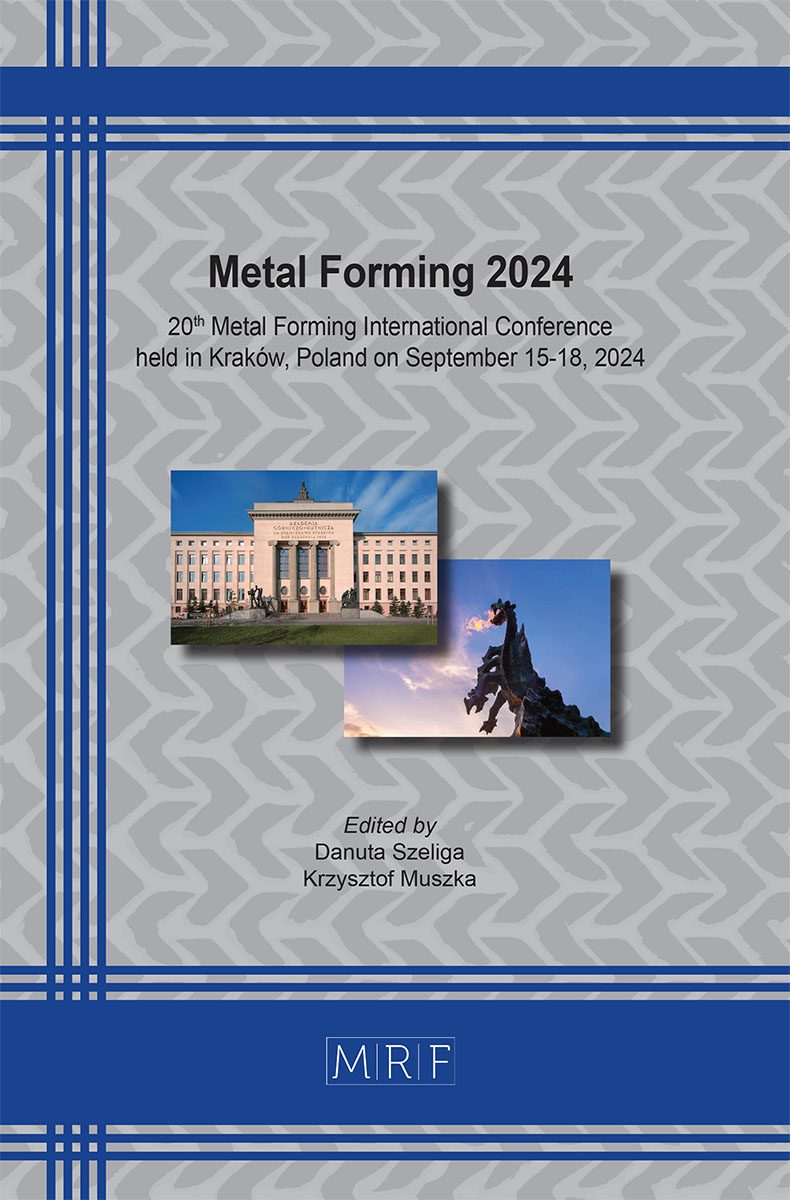–
New evaluation method for cold-forge solid phase bonding of dissimilar metals
OKAMOTO Haruki, ABE Eiji, HARADA Hiroshi, YUKAWA Nobuki
download PDFAbstract. Solid phase bonding is an effective method for joining dissimilar metals. Solid phase bonding is the bonding method without fusing metal matrix. Using this method, clad metal which is joined with sheet metals is in practice. However, the parameters to achieve stable cold-forge solid phase bonding in bulk are not well known. To investigate the parameters that affect the solid phase bonding state, a new test method to evaluate the strength of the bonding interface obtained by cold forging was developed. Using this method, test pieces bonded with S10C/A1070 and SUS304/A1070 were made in fluctuating interface bonding parameters (the surface area expansion ratio, the surface pressure). Although tensile test results showed large variation in joining strength at low value of bonding parameters, bonding was strong enough to exceed the A1070 base metal strength at the region of high value of bonding parameters. As it was found that the bonding parameters were able to measure the effect on joining strength in this experiment, it is considered that bonding parameters for solid phase bonding can be evaluated by the newly developed test method.
Keywords
Solid Phase Bonding, Forging, Steel, Aluminum
Published online 9/15/2024, 11 pages
Copyright © 2024 by the author(s)
Published under license by Materials Research Forum LLC., Millersville PA, USA
Citation: OKAMOTO Haruki, ABE Eiji, HARADA Hiroshi, YUKAWA Nobuki, New evaluation method for cold-forge solid phase bonding of dissimilar metals, Materials Research Proceedings, Vol. 44, pp 182-192, 2024
DOI: https://doi.org/10.21741/9781644903254-20
The article was published as article 20 of the book Metal Forming 2024
![]() Content from this work may be used under the terms of the Creative Commons Attribution 3.0 license. Any further distribution of this work must maintain attribution to the author(s) and the title of the work, journal citation and DOI.
Content from this work may be used under the terms of the Creative Commons Attribution 3.0 license. Any further distribution of this work must maintain attribution to the author(s) and the title of the work, journal citation and DOI.
References
[1] Fujimoto yuichiro, Urushiyama Yuta, Automotive multi-material strategy (2017) 115-127, in Japanese.
[2] ASM HANDBOOK vol.3 (2016) 133.
[3] H. Yamagisi, High-productivity and high-strength Fe/Al dissimilar metal joining by spot forge welding, Mater. Lett. 278 (2020) 128412. https://doi.org/10.1016/j.matlet.2020.128412
[4] K. Martinsen, Joining of dissimilar materials, CIRP Annals-Manuf. Tech. 64 (2015) 679-699. https://doi.org/10.1016/j.cirp.2015.05.006
[5] R.F. Tylecote, The Solid Phase Welding of Metals, Edward Arnold Ltd., (1968) 226-318.
[6] Y. Fang, W. Gai, H. Yang, B. Lu, Modelling and lock-seam effects on compressive behaviour of concrete-filled helical corrugated steel tubes, Structure 58 (2023) 105321. https://doi.org/10.1016/j.istruc.2023.105321
[7] Y. Abe, K. Mori, T. Kato, Joining of high strength steel and aluminium alloy sheets by mechanical clinching with dies for control of metal flow, J. Mater. Process. Tech. 212 (2012) 884-889. https://doi.org/10.1016/j.jmatprotec.2011.11.015
[8] N. Bay, Trans. ASME, J. Eng. Ind. 101 (1979) 121-127.
[9] X. Liu, Analysis of process parameters effects on friction stir welding of dissimilar aluminum alloy to advanced high strength steel, Metal. Des. 59 (2014) 50-62. https://doi.org/10.1016/j.matdes.2014.02.003
[10] S.H. Carpenter, R.H. Wittman, Annual Review of Mater. Sci. (1975) 177-199.
[11] M.G. Nicholas, R.M. Crispin, Diffusion bonding stainless steel to alumina using aluminium interlayers, J. Mater. Sci. 17 (1982) 3347-3360. https://doi.org/10.1007/BF01203505
[12] G. Chen, X. Chang, G. Liu, Q. Chen, F. Han, S. Zhang, Z. Zhao, Formation of metallurgical bonding interface in aluminum-steel bimetal parts by thixotropic-core compound forging, J. Mater. Process. Tech. 283 (2020) 116710. https://doi.org/10.1016/j.jmatprotec.2020.116710
[13] D. Chicot, Mechanical properties of magnetite (Fe3O4), hematite (α-Fe2O3) and goethite (α-FeO·OH) by instrumented indentation and molecular dynamics analysis, Mater. Chem. Phys. 129 (2011) 862-870. https://doi.org/10.1016/j.matchemphys.2011.05.056
[14] M.K. Tripp, The mechanical properties of atomic layer deposited alumina for use in micro- and nano-electromechanical systems, Sensors and Actuators A: Physical 130-131 (2006) 419-429. https://doi.org/10.1016/j.sna.2006.01.029
[15] H. Yamagishi, Spot Forge-Welding for Rapid Dissimilar Joining of Fe to Al to Produce an Intermetallic Compound-Free Interface, Mater. Trans. 62 (2021) 1576-1582. https://doi.org/10.2320/matertrans.MT-M2021080
[16] Y. Miwada, T. Ishiguro, E. Abe, N. Yukawa, T. Ishikawa, T. Suganuma, Cold Forge Spot-bonding of High Tensile Strength Steel and Aluminum Alloy Sheets, Procedia Eng. 81 (2014) 2006-2011. https://doi.org/10.1016/j.proeng.2014.10.272
[17] P. Groche, S. Wohletz, A. Erb, A. Altin, Effect of the primary heat treatment on the bond formation in cold welding of aluminum and steel by cold forging, J. Mater. Process. Tech. 214 (2014) 2040-2048. https://doi.org/10.1016/j.jmatprotec.2013.12.021
[18] R. Matsumoto, Improvement in bonding strength by applying circumferential sliding in cold copper/aluminum forge-bonding, J. Mater. Process. Tech. 307 (2022) 117685. https://doi.org/10.1016/j.jmatprotec.2022.117685
[19] L. Straka, I. Corny, J. Borzikova, Strojarstvo 51 (2009) 633-640.
[20] S. Ossenkemper, C. Dahnke, Analytical and experimental bond strength investigation of cold forged composite shafts, J. Mater. Process. Tech. 264 (2019) 190-199. https://doi.org/10.1016/j.jmatprotec.2018.09.008












